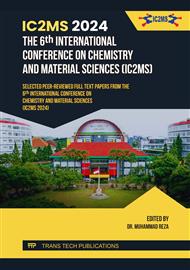p.3
p.15
p.21
p.33
p.47
p.57
p.69
p.75
Activation of Biochar from Coconut Shell Using H3PO4 for Adsorption of NO3-
Abstract:
In this work, the activated biochar from coconut shell have prepared using H3PO4 with different concentration as activating agent. The obtained activated biochars were characterized by Fourier transform infrared (FTIR) and Iodine number. Effect contact time on the adsorption capacity was studied through batch adsorption. Equilibrium adsorption data was evaluated by Langmuir dan Freundlich isotherm model. As the result, The FTIR analysis revealed a new peak at 982 cm⁻¹ in the activated biochar, corresponding to a P-O group, which was absent in the pristine biochar. The activated biochar obtained had iodine number range from 761 to 1093 mg/g with the highest iodine number biochar activated by H3PO4 of 30%. Different concentrations of H3PO4 resulted in different optimum contact times of adsorption ranging from 20-60 minutes. Biochar activated by H3PO4 of 30% has the shortest optimum contact time with an adsorption capacity of 4.99 mg/g. Freundlich isotherm model provided better fit than to Langmuir isotherm model. The research results contribute to the development of sustainable and renewable adsorbent materials for the recovery or waste water treatment especially for nitrate.
Info:
Periodical:
Pages:
15-20
Citation:
Online since:
July 2025
Keywords:
Price:
Сopyright:
© 2025 Trans Tech Publications Ltd. All Rights Reserved
Share:
Citation:


